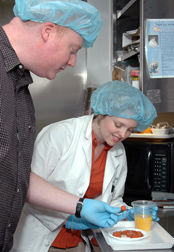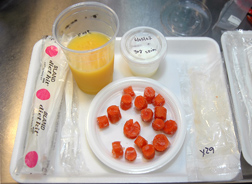Boosting Calcium in Carrots—and Other Veggies
|
|
Thanks to research at the USDA-ARS Children’s Nutrition Research Center (CNRC) in Houston, Texas, led by professor of pediatrics Kendal Hirschi, carrots have been modified to contain more calcium—and this research can potentially be used to add calcium to other crops.
The current U.S. recommended average intake of calcium for adults aged 19 to 50 is about 1,000 milligrams daily, and milk is one of the richest sources of calcium. Inadequate dietary calcium, however, is a global concern, particularly in parts of the world that don’t have access to dairy products or where large segments of the population are lactose intolerant or consume a vegetarian diet.
A Global Concern
Increasingly, dietary recommendations around the world emphasize the value of adequate intake of plant-based foods. But one major potential problem with shifting to a plant-based diet is that doing so could further reduce consumption of essential nutrients, such as calcium.
Insufficient intake of calcium may lead to osteoporosis, one of the world’s most prevalent nutritional disorders. It’s a condition that reduces bone mineral density and leads to fragile bones in later life. Doctors usually prescribe calcium supplements and exercise, but better calcium uptake and absorption from foods would also have a significant positive global impact on this disease.
Poor diets and exercise habits prevent many people from achieving and maintaining optimal bone health in the United States and elsewhere. To help combat this, Hirschi modified carrots by giving them a gene—from the model plant Arabidopsis thaliana—that encodes a calcium transporter.
CNRC professor of pediatrics Steve Abrams was involved in the subsequent human feeding studies. CNRC plant biologists helped in modifying foods, other than carrots, to have increased calcium levels.
Hirschi notes that CNRC, which is operated by Baylor College of Medicine in cooperation with Texas Children’s Hospital and the Agricultural Research Service, provides a unique research environment. There, it’s possible for scientists to generate genetically modified plants and then conduct careful feeding studies with mice and human volunteers, all in the same building—a one-of-a-kind operation needed for this type of work.
But Can the Body Use It?
While carrots already contain some calcium, it is very minimal. That means that no one could ever eat enough regular carrots to meet the recommended level of calcium.
The goal of the research was to induce carrots to express increased levels of the gene sCAX1, which enables transport of calcium across plant cell membranes. The ultimate goal is to make not only carrots, but also other vegetables and fruits, better sources of calcium. Further, the knowledge gained from this proof-of-principle research helps scientists understand molecular factors that influence plant nutrient bioavailability.
To determine the bioavailability of the calcium in the modified carrots, 30 volunteers—15 females and 15 males of various ethnic backgrounds and in their early to late 20s—ate single meals containing either regular or modified carrots. Both types of carrots were labeled with a stable isotope of calcium. Studies using stable isotopes are extremely safe, and this one allowed researchers to measure calcium absorption quickly.
After 1 day, urine samples were collected for measurement of calcium excretion. After 2 weeks, the volunteers returned to eat another carrot meal, switching from regular to modified, or vice versa, so comparisons could be made. The researchers found that the calcium intake of volunteers who consumed the modified carrots increased by 41 percent, compared to those who ate regular carrots. Though the percentage of calcium absorbed was slightly lower in the modified carrot, the total amount absorbed overall was significantly greater.
“We are always looking at ways to increase the nutrient content in foods,” says Hirschi, who has been working on this type of research for the past 7 years. “This is the first time a genetically enhanced food has been tested in clinical human feeding trials for increased nutrition, and the results were positive: We found we had indeed made a healthier carrot. Obviously, this is a prototype of what we want to develop in the future, but the early work is encouraging.”
What More Calcium Can Do
These findings, published in the January 2008 Proceedings of the National Academy of Sciences, show that it’s possible to improve the amount of bioavailable calcium in a staple food—such as carrots. When applied to a variety of fruits and vegetables, a strategy of increasing the calcium content of those foods that kids like to eat could lead to higher calcium consumption from plant foods alone.
In addition to the nutritional benefits, modifying plant genes to increase calcium levels could also improve plant productivity and extend product shelf life. That’s because calcium has long been used to combat many postharvest issues. For example, apples are immersed in a calcium solution to maintain their firmness during shipping and prolong their shelf life afterwards.—By Alfredo Flores, Agricultural Research Service Information Staff.
This research is part of Human Nutrition, an ARS national program (#107) described on the World Wide Web at www.nps.ars.usda.gov.
Kendal Hirschi is with the USDA-ARS Children’s Nutrition Research Center, 1100 Bates Ave., Houston, TX 77030; phone (713) 798-7011, fax (713) 798-7171.
"Boosting Calcium in Carrots—and Other Veggies" was published in the November/December 2008 issue of Agricultural Research magazine.








